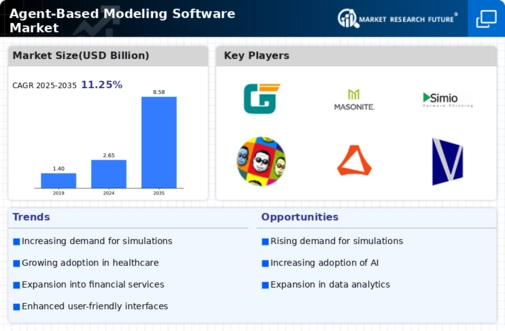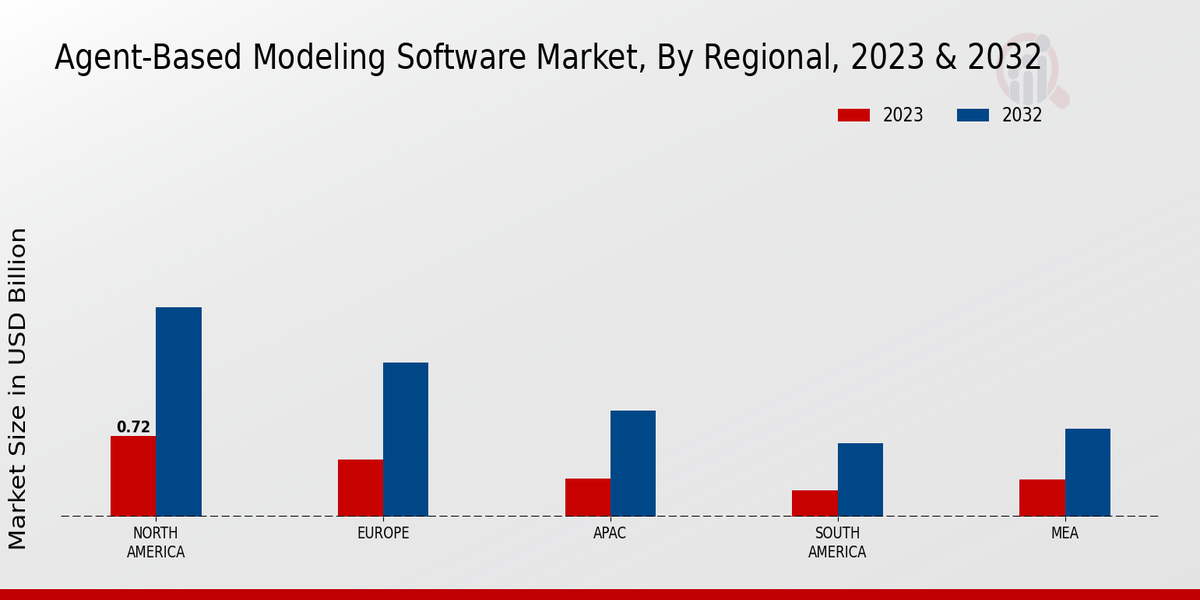Market Growth Projections
The Global Agent-Based Modeling Software Market Industry is projected to experience substantial growth, with estimates indicating a market size of 2.65 USD Billion in 2024 and a remarkable increase to 8.58 USD Billion by 2035. This growth trajectory suggests a compound annual growth rate of 11.27% from 2025 to 2035, driven by various factors including technological advancements, increased demand for simulation across sectors, and the integration of agent-based models with emerging technologies. Such projections highlight the industry's potential and the growing recognition of agent-based modeling as a vital tool for addressing complex challenges in diverse fields.
Rising Need for Data-Driven Decision Making
The Global Agent-Based Modeling Software Market Industry is propelled by an increasing emphasis on data-driven decision-making across organizations. As businesses strive to harness the power of big data, agent-based modeling provides a framework for analyzing complex interactions and deriving actionable insights. This approach is particularly relevant in sectors like logistics and supply chain management, where understanding agent interactions can lead to improved efficiency and cost savings. The growing reliance on data analytics is expected to contribute to a compound annual growth rate of 11.27% from 2025 to 2035, underscoring the software's pivotal role in modern strategic planning.
Growing Focus on Environmental Sustainability
The Global Agent-Based Modeling Software Market Industry is witnessing a surge in interest due to the growing focus on environmental sustainability. Governments and organizations are increasingly utilizing agent-based modeling to simulate ecological systems and assess the impact of various policies on environmental outcomes. For example, agent-based models can help predict the effects of urban development on local ecosystems, guiding sustainable practices. This trend aligns with global sustainability goals, prompting investments in modeling software that can facilitate informed decision-making. As environmental concerns become more pressing, the market is expected to expand, reflecting a commitment to sustainable development.
Advancements in Computational Power and Algorithms
The Global Agent-Based Modeling Software Market Industry benefits significantly from advancements in computational power and algorithmic development. Enhanced processing capabilities allow for the simulation of larger and more complex systems, which was previously unattainable. For example, the integration of machine learning algorithms with agent-based modeling enables more accurate predictions and adaptive simulations. This evolution is likely to attract a broader range of users, from academic researchers to corporate strategists, thereby expanding the market. As computational resources become more accessible, the industry is poised for substantial growth, with projections indicating a market size of 8.58 USD Billion by 2035.
Increasing Demand for Simulation in Various Sectors
The Global Agent-Based Modeling Software Market Industry experiences heightened demand across diverse sectors such as healthcare, finance, and urban planning. Organizations increasingly leverage agent-based modeling to simulate complex systems and predict outcomes, enhancing decision-making processes. For instance, in healthcare, agents can represent patient behaviors, enabling better resource allocation. As a result, the market is projected to reach 2.65 USD Billion in 2024, reflecting a growing recognition of the software's utility in addressing multifaceted challenges. This trend indicates a robust trajectory for the industry, as more sectors adopt simulation technologies to optimize operations.
Integration of Agent-Based Models with IoT Technologies
The Global Agent-Based Modeling Software Market Industry is increasingly influenced by the integration of agent-based models with Internet of Things (IoT) technologies. This convergence allows for real-time data collection and analysis, enhancing the accuracy and relevance of simulations. For instance, in smart city initiatives, agent-based models can simulate traffic patterns based on real-time data from connected vehicles and infrastructure. This synergy not only improves urban planning but also fosters sustainable development. As IoT adoption continues to rise, the demand for agent-based modeling software is likely to escalate, further driving market growth.













